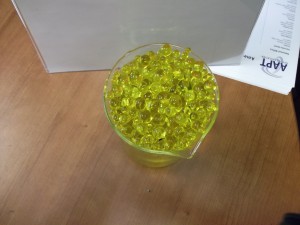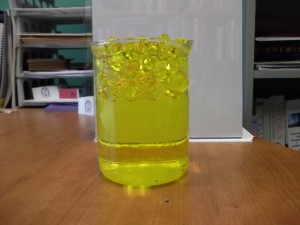Being a physics teachers changes you. I think even when you are not teaching, somewhere in the back of your mind, you keep thinking about it. It became apparent to me when I entered a dollar store (a place frequently visited by teachers) and noticed very cool beads. They are sold as handmade 4D Crystal Soil Pearls. Apparently they are famous in Canada and you can find them all over the place here. They are used for gardening and for plants at home. However I found them to be really cool teaching demo. The beads come in a small bag (10 g or 0.35 Oz) and are made of poluacrylamede. When you soak them in water they will increase in volume by 180-200 times. It takes the beads about 8-10 hours to reach this size, but the increase is apparent. Even during a lesson the beads will change from 3-4 mm in diameter to about 1 cm. Here is how I used the beads in my science methods courses for elementary teachers:
1) Let the beads soak in water and ask the students to observe what happens. Discuss the diameter-surface area-volume ratio.
2) The beads come in different colours. When you soak them in water the beads at the bottom disappear – an excellent discussion of matching of indices of refraction. I do a similar demo with glass and canola oil, but the beads are even easier to use.
3) When you let the beads stay for a number of days, the beads of the top surface will become small again and you will see a gradient in size- discussion of evaporation from the surface…
4) Different colours of the beads – you can mix them us and ask the students to predict what is going to happen and then explain why it happens. The beads come in different colours.
5) Discuss how these beads can be used in agriculture and gardening…
CAUTION: You do not want the students to swallow the beads – so I would be careful with doing these activities with very young kids (I will be using them as demos), but with the older students, I would share one bag with the class and allow different group to use them. Just make sure you use a transparent glass or a plastic transparent coffee cup, so the students can see what is happening…

